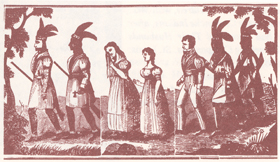|
Appendix I Early Graphic Artists and the Indian Captivity Narrative-A Contribution to the History of American Book Illustration Before many books in America possessed illustrations of any sort, printers added exciting, melodramatic and lurid detail to the many Indian captivity narratives which they published through numerous illustrations gathered from contemporary artists. Indeed, some of the first illustrated books in America were captivity narratives. As if the graphic imagery detailed in the prose were not enough to set the tone of these works, it was almost as if pictures could add to the veracity of the extraordinary and frightening tales.
The illustration of captivity narratives grew out of this tradition, in part, along with the tradition of illustrating saints' lives and martyrdoms and the violence of the religious wars between Catholic and Protestant during the Reformation and the early modern historical age. |
|
|
|
||
|
|
||
|
|
||
|
|
||
|
|
|
|
|
|
||
